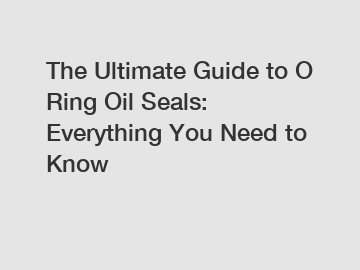The Ultimate Guide to O Ring Oil Seals: Everything You Need to Know
The Ultimate Guide to O Ring Oil Seals: Everything You Need to Know.
O ring oil seals play a crucial role in various industries, ensuring the proper functioning of machinery and preventing leaks and contamination. In this comprehensive guide, we will delve into the details of O ring oil seals, discussing their construction, applications, benefits, and the factors to consider when selecting the right seal for your specific needs.
First and foremost, let's understand what O ring oil seals are and how they work. These seals are circular in shape and are made from elastomeric materials such as nitrile rubber, silicone, or fluoroelastomer. They are designed to create a tight and reliable seal between two mating surfaces, preventing the leakage of fluids and gases. The flexibility and resilience of these seals allow them to adapt to the mating surfaces' irregularities, effectively sealing off any potential leak paths.

The construction of O ring oil seals incorporates several critical elements. The most vital component is the sealing lip, which is responsible for creating the actual seal. It is designed to have a precise contact area with the mating surface, ensuring maximum sealing effectiveness. Additionally, O ring seals may also include secondary sealing lips or dust lips to provide extra protection against contaminants, ensuring the longevity of the seals and the machinery they are installed in.
The applications of O ring oil seals are widespread across industries such as automotive, aerospace, manufacturing, and hydraulic systems. These seals are commonly used in engine components, gearboxes, pumps, cylinders, and hydraulic systems, among others. Their ability to withstand various temperatures, pressures, and fluid types makes them versatile and essential in numerous applications.
When selecting the right O ring oil seal for your specific needs, several factors should be considered. Firstly, the material of the seal is crucial, as it dictates the compatibility with different fluids and operating conditions. Nitrile rubber seals are resistant to oils and fuels, while silicone seals offer excellent resistance to extreme temperatures. Fluoroelastomer seals, on the other hand, exhibit exceptional resistance to chemicals and high temperatures.
Furthermore, the size and dimensions of the O ring oil seal must be carefully chosen to ensure a proper fit and effective sealing. Proper installation techniques also play a significant role in the longevity and performance of the seals. Whether it's the installation of radial seals or axial seals, following the recommended guidelines and using appropriate tools and lubricants is essential.
In conclusion, understanding the ins and outs of O ring oil seals is crucial for anyone operating machinery or involved in industries that heavily rely on these seals. The proper selection, installation, and maintenance of these seals ensure the smooth operation of equipment, prevent leaks and contamination, and ultimately contribute to the overall efficiency and productivity of industrial processes. By following the guidelines outlined in this ultimate guide, you can confidently choose the right O ring oil seal for your specific application and maximize its benefits.
Are you interested in learning more about chinese rubber oil seal, wholesale colored rubber o rings, square rubber blocks? Contact us today to secure an expert consultation!
142
0
0


Comments
All Comments (0)